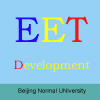-
VR for the Handicapped
普通类 -
- 支持
- 批判
- 提问
- 解释
- 补充
- 删除
-
-
VR for the Handicapped
VIRTUAL REALITY (VR) is a computer-based technology that can be used to enhance the lives of the handicapped. Specialized input and output devices for the head, hand, and ankle, combined with their virtual reality components, can be used to aid the handicapped with visual impairments, pain control, task performance, communication, and rehabilitation.-
Head Mounted Devices
A stereoscopic head-mounted display device is similar to a pair of goggles with headphones attached that the user wears over his/her eyes. In front of each eye is a little display screen that fills the user's field of vision with three dimensional images, as well as sound.
Visually impaired man in virtual world slowly feels and lifts a vase.
Visual Impairments: A head device providing entry into a virtual world, can provide a safe environment for the visually impaired to learn and practice new skills. By designing a virtual world where objects are given distinct profiles (using heavy outlines), a visually impaired person can learn how to distinguish and use various tools. By making the virtual world continuously more like the real world, the user can acquire the knowledge and confidence that will enable him to perform tasks correctly in the real world (Middleton, 1992, Safe Environment section, para. 3).
Pain Control: At the University of Washington Harborview Burn Center, head devices that play VR games (SpiderWorld and SnowWorld) are being used to distract people undergoing painful dressing changes.-
Glove Devices
Glove devices are generally made of thin cloth with fiber optic cables running along their surfaces. Any hand movements are recorded by sensors and transmitted to a computer. Various types of gloves are used to aid the handicapped in task performance, communication, and rehabilitation.

Hand movements using GloveTalkII are translated into text and speech.
Task Performance: A DataGlove allows people to perform complicated tasks through simple hand gestures (such as operating specially designed telephone switchboards, controlling complex robotics equipment, or navigating computer interfaces and software).
Communication: The GloveTalkII, a modified DataGlove, converts hand movements (by those unable to speak) into speech synthesized spoken words and text.
Rehabilitation: The CyberGlove® tracks and records a person's hand movements. It can pinpoint weaknesses in range, speed, strength of movement, as well as individual finger movements, and can provide strength exercises to improve a patient's grasp.
Rehabilitation: The Rutgers Master Glove (RMII), is an exoskeleton, force-feedback device that applies force to the user's fingertips and relays the user's information back to a computer. It enables someone with hand and finger weakness (such as stroke victims) to build up strength by doing force exertion exercises. Monitoring the patient's progress can be done remotely by therapists and doctors.-
Ankle Device
An ankle device consists of a platform based interface, an electropneumatic control box, a PC host computer, and a mini-compressor. When a user's ankle is strapped to a computer controlled platform, the computer measures the foot position and orientation, and then provides resistive forces and torques through the platform to the user.

Patient with Rutgers Ankle device controls flight simulator game.
Rehabilitation: The Rutgers Ankle device benefits persons with mobility disabilities by providing physical therapy through virtual reality. A patient using a Rutgers ankle device can control a 3D flight simulator game on a computer screen. The foot device receives feedback from the game software and applies different levels of force which the user must counteract in order to navigate a plane on the screen. Using this form of virtual reality, a person can strengthen his muscles, improve his balance, and regain the use of his ankle.-
Additional Information on VR
California State University, Northridge: A good source for articles on Virtual Reality and Persons with Disabilities.
Rutgers University: Virtual Reality Lab.
International Society for Technology in Education (ISTE): Article on Special Education and Virtual Reality: Challenges and Possibilities.-
Author
Caroline Willi
Graduate student
SDSU Educational Technology
... -
-
- 标签:
- rutgers
- virtual
- world
- handicapped
- devices
- reality
- movements
- control
- vr
- device
- ankle
- hand
-
加入的知识群:



学习元评论 (0条)
聪明如你,不妨在这 发表你的看法与心得 ~